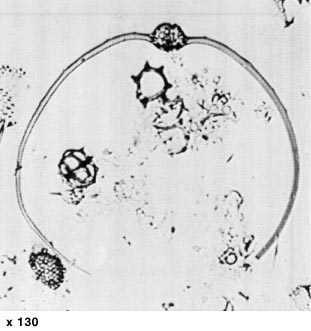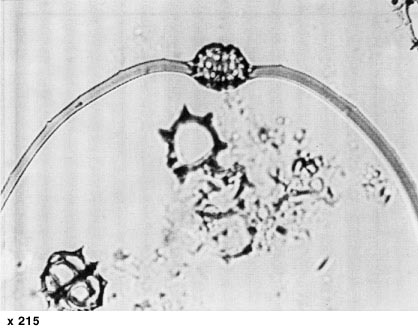 Dorcadospyris
alata (Riedel)
Dorcadospyris
alata (Riedel) Dorcadospyris
alata (Riedel)
Dorcadospyris
alata (Riedel)Brachiospyris alata Riedel, 1959, p.293, pl.1, figs.11-12
Dorcadospyris alata (Riedel), Riedel and Sanfilippo, 1970, p.523, pl.14, fig.5
Shell thick-walled, nut-shaped, tuberculate, with slight sagittal stricture externally and subcircular to circular pores irregularly arranged and separated by wide intervening bars. Two feet, circular in section, widely divergent, proximally at 180░ or sometimes more, subsequently curved downward to a greater or lesser extent, in occasional specimens approximately semicircular. The outer edges of the feet of most specimens bear short conical spinules. This species is distinguished from all other members of the genus by the pronounced divergence of the feet and the tendency to the development of accessory spinules on the feet (Riedel, 1959).
Length of shell 50-68 Ám; of feet 285-930 Ám; of accessory spinules 3-13 Ám; breadth of shell 55-78 Ám. The maximum width, across the semicircularly curved feet, is 565-775 Ám (Riedel, 1959; Sanfilippo et al., 1985).
 DISTINGUISHING
CHARACTERS
DISTINGUISHING
CHARACTERSShell small and thick-walled, with two very widely divergent feet bearing short thorns (Riedel and Sanfilippo, 1978a).
See also Dorcadospyris dentata herein.
The angle between the proximal parts of the widely divergent feet is frequently slightly more than 180░. Thorns on the feet are variably developed (Sanfilippo et al., 1985).
A middle Miocene species. There are no noticeable morphologic differences in various parts of its geographic range, which extends throughout the low latitudes, but not to latitudes higher than about 30░ except in the Mediterranean region (absent at DSDP Sites 173, 206, 281, 338) (Sanfilippo et al., 1985).
The evolutionary transition of this species from Dorcadospyris dentata defines the base of the Dorcadospyris alata Zone and its morphotypic last appearance is approximately synchronous with the upper limit of the same zone.
Additional illustrations can be found in Riedel and Sanfilippo, 1971, pl.2D, fig.l; Riedel and Sanfilippo, 1978a, pl.5, fig.2; Goll, 1972, pl.4, figs.1-3, pl.41, figs.1-3.